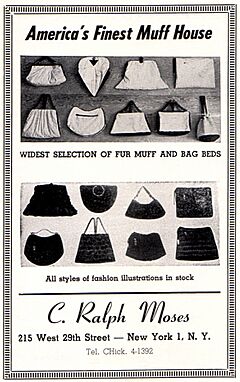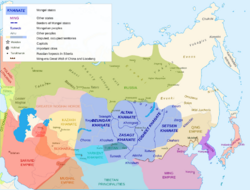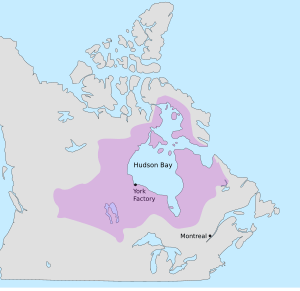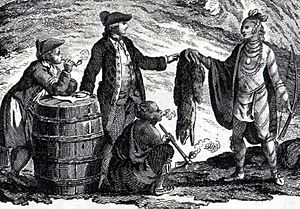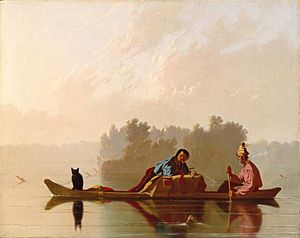Fur trade facts for kids

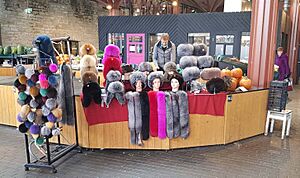
The fur trade is a global business. It involves getting and selling animal fur. For a long time, furs from animals in cold places were very valuable. This trade helped explore and settle new lands. These included Siberia, northern North America, and some islands near Antarctica.
Today, the fur trade is not as big as it once was. Most furs now come from special fur farms. Some also come from regulated trapping of animals. However, many groups that protect animals disagree with the fur trade. They believe it harms animals. Because of this, some clothes now use fake fur instead of real fur.
Contents
Exploring the Global Fur Trade
Russia's Historical Fur Trade
Before Europeans came to the Americas, Russia was a main supplier of furs. It sold furs to Western Europe and parts of Asia. This trade started a very long time ago, around 500 to 1000 AD. Furs were exchanged at trading posts around the Baltic Sea and Black Sea. The German city of Leipzig was a big market for these furs.
Russia first exported raw furs. These often came from martens, beavers, wolves, foxes, squirrels, and hares. From the 1500s to the 1700s, Russians moved into Siberia. This region had many valuable fur animals. These included Arctic fox, lynx, sable, sea otter, and ermine. The search for prized sea otter pelts led Russia to expand into Alaska. For many years, Russia was the world's largest fur supplier. The fur trade was very important for developing Siberia and Russian America.
Siberian Fur Trade Expansion
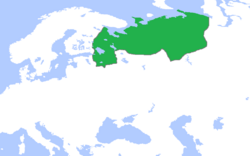
As early as the 900s, merchants from Novgorod used the fur resources of northern Eurasia. They set up trading posts along rivers. They asked local people, like the Komi, to give them furs as a special payment called a tribute. Novgorod became a major fur trade center. It was the easternmost trading post of the Hanseatic League.
Later, the Grand Principality of Moscow grew stronger. It began to compete with Novgorod for the fur trade. Eventually, Moscow took over Novgorod and its lands. Moscow also started to control many native tribes. They sometimes used different tribes to fight against each other. These efforts to control Siberia grew much larger in the late 1400s.
Russian explorers and traders moved deeper into Siberia. They built small forts or winter camps called zimovye. Here, they lived and collected fur payments from native tribes. By the 1620s, Russia controlled a huge area from the Ural Mountains to the Yenisei River.
Furs became Russia's biggest source of wealth for many years. Russia needed money to buy goods from Western Europe. Since it didn't have much gold or silver, furs became known as "soft gold." This "soft gold" allowed Russia to buy things like metals, textiles, and firearms. Russia also traded furs with countries in the Middle East for silk and spices. The high demand for furs like sable and black fox caused a "fur fever." Many Russians moved to Siberia to become independent trappers.
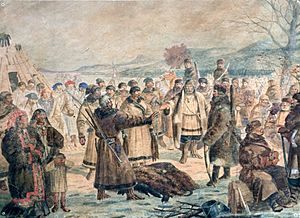
The main way Russia got furs was through the yasak tax. This was a fixed number of sable pelts. Every male tribe member, aged 15 or older, had to give these to Russian officials. Officials often used force or took family members as hostages to ensure payment. At first, Russians traded goods for furs. But as demand grew, force became more common. Many Russian governors were corrupt. They often took extra furs for themselves.
Russian fur trappers were called promyshlenniki. They hunted in groups of 10-15 men. Some groups were independent, sharing costs and furs equally. Others were hired by trading companies. These companies paid for the trips. After the hunt, the company got most of the furs. The rest were sold, and the money was shared among the hired trappers. Trapping season usually lasted from October to early spring. Many trappers chose to stay and settle in Siberia because the journey back was long and expensive.
North America's Fur Trade
The North American fur trade started in the 1500s. Europeans traded with First Nations people. This trade was a key part of early contact between these groups. Sailors first traded metal tools, like knives, for animal pelts. Beaver and sea otter furs were especially popular. Deer, bear, and fox furs were also traded.
Beaver pelts were used to make warm blankets. These pelts were also very useful for making felt hats. These hats were a popular and expensive fashion item in Europe. The demand for beaver hats was so high that beavers in Europe became very rare.
Early Trading Systems in North America
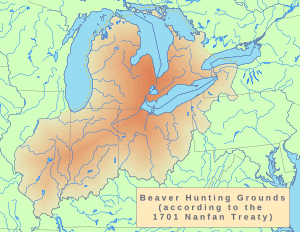
Early French explorers like Samuel de Champlain and traders like Étienne Brûlé built relationships with Amerindians. They expanded the trade of furs for European goods. Warm winter pelts were highly valued. Beaver fur was especially important for making felt hats. These hats were a sign of wealth in Europe.
The Dutch also joined the fur trade in the early 1600s. They set up trading posts, like Fort Orange (now Albany). Much of their fur came from Canada. It was often brought south to avoid French trade rules.
England was a bit slower to start. But English colonies soon found that furs were a great way to send value back home. Furs were sent from Virginia by 1610. The Plymouth Colony also sent many beaver pelts to London. English merchants tried to take over the French fur trade in the St. Lawrence River valley.
In 1668, the English fur trade changed. Two French traders, Pierre-Esprit Radisson and Médard des Groseilliers, had great success trading west of Lake Superior. They believed the best furs were far to the north and west. They thought these areas could be reached by ships sailing into Hudson Bay. They eventually got support from English investors.
Two ships were sent in 1668. One, the Nonsuch, successfully reached Hudson Bay. It traded with local people and brought back many beaver skins. This success led to the creation of the Hudson's Bay Company in 1670. This company received a special right to trade in all rivers flowing into Hudson Bay. They sent ships yearly, selling furs (mostly beaver) in London.
In the southern colonies, a deerskin trade began around 1670. It was based in Charleston, South Carolina. Native hunters learned that Europeans would trade pelts for desired goods. These goods included axe heads, knives, cloth, blankets, kettles, and firearms.
European traders made large profits. For example, a metal axe head could be traded for one beaver pelt. That same pelt could buy many axe heads in England. Native people benefited too. They got iron axe heads, which were much easier to use than their handmade stone ones.
The fur trade began to slow down in the 1830s. Fashion changed, and beaver hats became less popular. European settlements also pushed native communities away from hunting grounds. Native American ways of life changed. To keep getting European goods, they sometimes sold land to settlers. This caused tension and led to future conflicts.
After the United States became independent, it regulated trade with Native Americans. Many early explorers were also fur traders. They helped map out new regions of North America.
Cultural Connections in the Fur Trade
The fur trade often created strong connections between different cultures. These connections were sometimes more important than just making money. Trade helped form alliances and keep good relationships. Many fur traders were young men who traveled to North America. They often formed families with high-ranking Indigenous women. This led to new mixed-heritage communities. In Canada, these people are known as the Métis. They developed their own unique culture, based on hunting, trapping, and farming.
Because of the valuable furs, different European governments and native groups competed for control of the trade. Native Americans sometimes chose which side to support in wars based on who offered the best and fairest trade. Europeans tried to control the trade to prevent unfair practices. However, some traders cheated native people, sometimes using alcohol. This often led to anger and violence.
The Fur Trade Today
Today, the fur trade continues, but it is much smaller. In Canada, about 60,000 people have trapping licenses. About 25,000 of these are indigenous peoples. Fur farming is also present in many parts of Canada. For example, Nova Scotia is a large producer of mink and fox furs.
In the U.S., there are about 176,573 trappers. Most of them are in the Midwest. California was the first state to ban trapping for commercial and fun purposes in 2015. The North American Fur Auction happens four times a year. Buyers from all over the world attend. About 270,000 families in the U.S. and Canada get some income from fur trapping.
Maritime Fur Trade
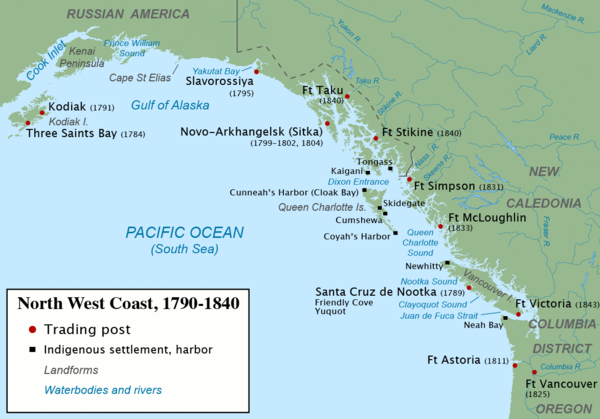
The maritime fur trade was a ship-based system. It focused on getting furs from sea otters and other animals. These furs came from the indigenous peoples of the Pacific Northwest Coast and Alaska. The furs were mostly traded in China for tea, silks, and porcelain. These Chinese goods were then sold in Europe and the United States.
Russians started this trade, moving east from Kamchatka to Alaska. British and Americans joined in the 1780s. They focused on the coast of what is now British Columbia. The trade grew quickly around 1800. It started to decline after 1810. As sea otter numbers dropped, the trade changed. It found new markets and goods.
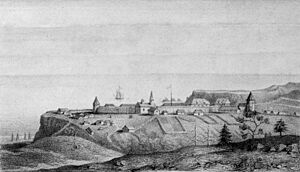
Russians controlled most of the Alaskan coast. South of Alaska, British and American ships competed fiercely. The British Hudson's Bay Company eventually pushed the Americans out by 1840. In its later years, the trade was mainly run by the British Hudson's Bay Company and the Russian-American Company.
This trade connected the Pacific Northwest coast to a new global network. It linked the Pacific Northwest, China, the Hawaiian Islands, Europe, and the United States. It had a big impact on the native people of the Pacific Northwest. Their wealth increased, but so did conflicts. There was also a spread of diseases. However, their culture remained strong and changed in new ways. The Chinook Jargon language developed during this time.
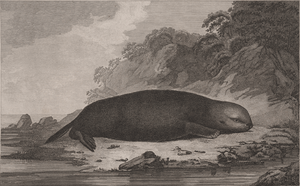
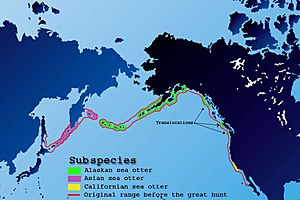
The most valuable furs came from sea otters. Especially the northern sea otter. After these otters were hunted too much, traders moved to California. There, the southern sea otter was also hunted almost to extinction. British and American traders took their furs to Guangzhou (Canton) in China. Furs from Russian America were mostly sold to China through a town called Kyakhta.
Images for kids
-
Sketches of life in the Hudson's Bay Company territory, 1875
-
Trapper's cabin in Alaska, 1980s
See also
 In Spanish: Comercio de pieles para niños
In Spanish: Comercio de pieles para niños
- Beaver Wars
- California Fur Rush
- The Coalition to Abolish the Fur Trade
- Coureur des bois
- Fur brigade
- List of fur trading post and forts in North America


